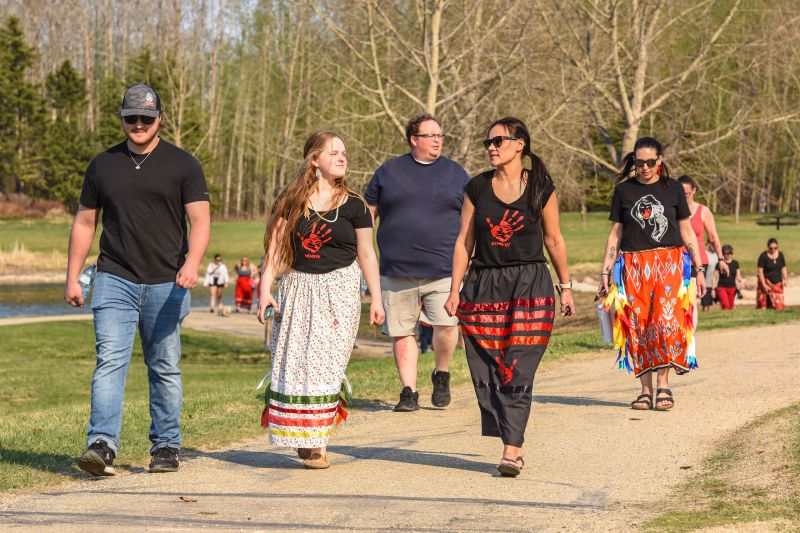
On Friday, May 5, the Whitecourt Indigenous Friends Society held its first annual National Day of Awareness & Action for MMIWG2S walk at Festival Park (previously named Rotary Park). MMIWG2S stands for Missing and Murdered Indigenous Women and Girls and Two-Spirited Peoples.
Faye Myshyniuk, president of the Whitecourt Indigenous Friends Society, said the board had recently met and discussed holding more events. “We were talking about different events that happen throughout the year. We decided to put together a calendar of all the different Indigenous events that go on because sometimes we forget them.”
At the recent meeting, someone said they should hold a walk for MMIWG2S. With little time to plan, the group felt it was more important to do the walk and that they could amp up the community’s involvement next year. “We want to put the awareness out there. It’s a crucial topic that many people don’t know about,” said Myshyniuk.
“We want to make sure that people know what it stands for. We just want to honour and remember the missing and murdered Indigenous women, girls, and two-spirited people. It’s an epidemic. It really is.” Those in attendance were asked to wear red, the movement’s signature colour, which is led by a vibrant red dress.
“I really wanted to get red dress pins, but there wasn’t any time for that so we can do that next year,” added Myshyniuk. “Our goal is to be out, where the public can see us and help raise awareness and education of all things related to Indigenous Peoples. That’s why we want to create the calendar. There are quite a few days to remember, like Indigenous Peoples Day, Red Dress Day, Orange Shirt Day, and then there’s another day in October for Indigenous Sisters. We have to remember all of these different days.”
In 2014, the RCMP acknowledged in a report that more than 1,200 Indigenous women were missing or murdered between 1980 and 2012. However, different Indigenous groups say the number is much higher, closer to 4,000. Underreported violence against Indigenous women and girls is one reason for the disagreement.
The Native Women’s Association of Canada (NWAC) has sounded the alarm over figures from Statistics Canada that show Indigenous women are dealing with higher rates of violence. Records from 2004 show that Indigenous women fifteen years of age and older were 3.5 times more likely to experience violence than non-Indigenous women. In 2019, Statistics Canada showed that almost one in ten Indigenous women were victims of violence and that from 2015-2020, homicides with Indigenous victims were six times higher than non-Indigenous people.
An inquiry into the MMIWG was released in 2019. Over 2,300 people participated in the truth-gathering process, and 231 calls to justice were recommended. Fifteen community hearings occurred from September 2016 to 2019, and 1484 family members and survivors shared their gut-wrenching testimonies.
Highway 16 in BC, near Prince George, is called the Highway of Tears by many. The 724 km stretch of the Yellowhead highway has been the site of many Indigenous victims. Twenty-three First Nations border the highway and the lack of public transportation results in high rates of hitchhiking. Human Rights Watch, a non-governmental organization focused on advocacy and research on human rights issues, said BC had the highest rate in Canada of unsolved murders of Indigenous women and girls.
In September last year, a monument was erected on Highway 16 called “Journey of Hope.” The memorial is of a red dress with an Indigenous dancer silhouetted in front of it. It stands atop a pole, visible to all who drive by. The monument was initiated by the Prince George’s Red Dress Society.
“It’s an epidemic. There have been calls to action for so many years about this, and now people are listening. Before, those calls to action were largely ignored. Finally, in 2016, when they did the National Inquiry into this, it made it very clear that Canada has a problem and that Indigenous people are paying for it,” said Myshyniuk.
She added that spreading awareness, just like the monument on the Highway of Tears, is a massive part of the conversation. “It leads along the path to truth and reconciliation. My biggest thing is that we can all be together as one nation and work together towards a better future for all mankind. None of this segregation and stuff like that. I think it’s important for us to all work together as one.”
Around forty people took part in the walk, which ran the perimeter of Festival Park Pond. “It’s a day of mourning, honouring, and taking action to end the violence, which is so important to me. Not only for the Indigenous women and the atrocities being largely ignored for all these years, but it also has much to do with domestic violence. That’s one thing that I am very set against. This fits right in with that. I’m really happy that several ladies from Wellspring will be joining us.”
Myshyniuk said she hopes that people who don’t know about the issue will look into it and learn more about it. “You owe it to yourselves, and you owe it to these victims to educate yourselves and learn more about it. They didn’t just die for no reason. I think it’s important to honour and remember them.” Myshyniuk, on behalf of the Whitecourt Friendship Society board, thanks everyone for participating. “It means a lot to all of us in society. It shows support, and that is so important.”







More Stories
Community spirit shines at large-scale youth baseball event
Birthday party chaos sung beautifully by Pumpjack Players’ youth in spring musical
Gearing up for another season of cars, cruising and camaraderie